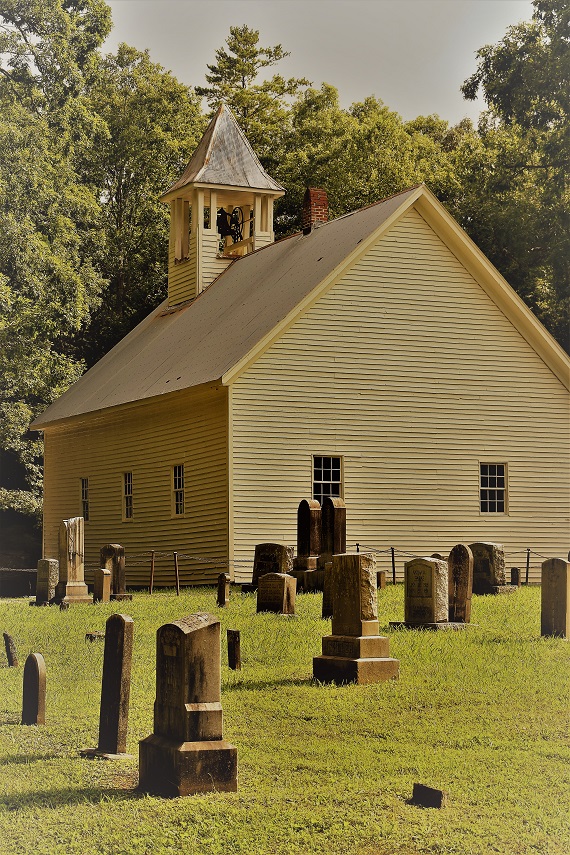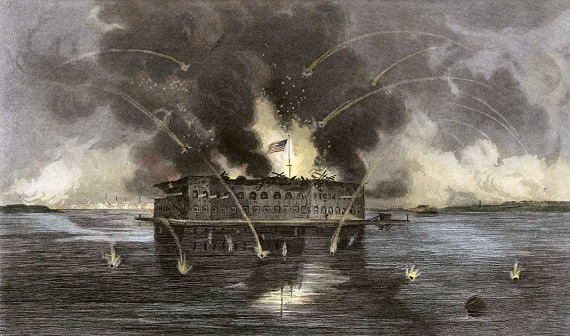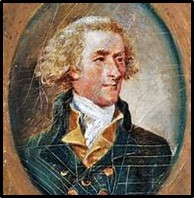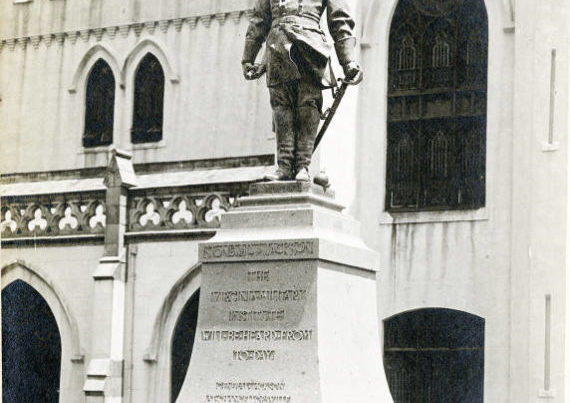
This essay was presented at our 2019 Summer School on the New South.
Fundamentalism is often viewed as the most Southern of religions. Yet this is not so. It was an alien seed planted in ground razed by war and harrowed by Reconstruction. The harrowing, or Reconstruction if one prefers, was not merely an updating of the constitutional and political order in the South, but an attempt to impose a new social, cultural, and religious order upon the ruins of the old. To best understand this process, the temptation to isolate the reconstruction of Southern religion must be avoided. There is an important, wider historical context concerning the religious life of modern man to be kept in mind, a context that affected Catholic and Protestant belief and worship.
As the late middle ages transitioned to the early modern era in European history, a subtle shift in western Christianity emerged. Religious life in Europe, once characterized primarily by communal worship and devotion began to shift toward individualized devotion and spirituality. An example of this shift occurred in Northern Europe and was known as the Devotio Moderna. This new form of devotion emphasized personal piety, scripture study in the original languages, moral reform, simplicity in devotions, penance, and the pursuit of personal sanctity. A group of lay and clerical associations, the best known being the Sisterhood and Brotherhood of the Common Life were devoted to this new, modern devotion. The Brotherhood of the Common also dedicated themselves to the education of both lay men and clerics, Such luminaries of the Northern Renaissance as Saint Thomas More and Erasmus received part or all of their education from the Brotherhood of the Common Life. The most singular work of the modern devotion Thomas a Kempis’s, The Imitation of Christ, emphasized the Christian’s personal relationship with Jesus Christ, and was found in the libraries of both Catholics and Protestants. Protestant emphasis upon the individual’s relationship with the person of Jesus Christ is well documented, but this same emphasis was also present in the Catholic Reformation before and after the Council of Trent. Saint Ignatius’s spiritual exercises and Carmelite meditation are two outstanding examples.
The modern devotion’s emphasis upon the individual’s spiritual life began to fuse with a late medieval philosophical movement, nominalism, resulting in the elevation of emotion as a guide to one’s religious life and spiritual state. In general, nominalists were skeptical regarding the powers of reason to ascertain and understand being or essence. This included Being itself, God. By limiting the intellectual faculty’s role in the discernment of the true, the good, and the beautiful, nominalists, either explicitly or by default, came to rely on revelation as the only sure guide in spiritual matters, particularly scripture. For the individual believer, revelation and emotion would gradually take more and more of the ground once occupied by the intellectual faculty in the spiritual life. In the world of evangelical Christianity, emotion played a singular role in the conversion experience of the Christianity.
The turmoil created by religious conflicts, the new commercial order, and the rise of the nation-state in the sixteenth and seventeenth centuries had an enormous effect upon the religious life of British North America. Secular rulers throughout Europe began to assert their authority over the churches within their realms. The Peace of Augsburg enshrined this new order within the confines of the Holy Roman Empire, as the head of state decide upon the religious confession of his subjects. Both Martin Luther and Henry VIII asserted the right of a prince to be the head of the Church within his realm, the views of the Gallicans expressed similar sentiments with respect to the powers of the French monarch over the Church within the borders of France. In the British Isles, control of the state became a matter of paramount concern for Catholics, Anglicans and Puritans throughout the 1600s. Indeed, the religious question would remain unsettled in the British Isles until the Glorious Revolution.
The religious conflicts between Anglicans, Catholics, Puritans, and other dissenters are well known. An example of the complexity of these conflicts can be found in an examination of the Battle of Worcester in 1651. An odd bed–fellows alliance of Catholics, Anglicans, and Scottish Presbyterians, fought against Cromwell’s Puritans for the establishment of the future Charles II upon the throne of his ill fated father, Charles I. George Mason’s ancestor, “the Cavalier,” fought in the royalist side in this uprising, and fled to Virginia after the royalist defeat. Mason’s family, which was at least nominally Anglican, was rumored to contain a crypto Catholic or two, not an entirely uncommon thing in the west of England in the mid seventeenth century. All of this suggests that the political and religious situation in the British Isles was topsy turvy.
The “Anglican Solution” achieved via the Glorious Revolution was limited in its success. The terms of the solution were simple, the Anglican Church was the established Church, the monarch of England was its head, believe what you wish, but do show up for weekly services, do pay your tithe, and don’t antagonize your neighbor. Penal laws were imposed upon Catholics, and to a lesser degree Protestant dissenters, to ensure compliance. The system did not transfer well to the settlements in British North America. Established churches, Anglican and Puritan, found themselves under the heel of colonial governments in short order. To be an “established church” meant that one received state support, financial and otherwise, from the colonial government, but toleration of dissenters was a matter of state policy with little input from the church. It was not uncommon for colonial governments in the eighteenth century to license preachers from dissenting groups, or allow for the building of places of worship by non-Trinitarian believers such as the Society of Friends, who also had their own colony in Pennsylvania. Even penal laws restricting the public activities of Catholics were sometimes strictly enforced and at other times lax in enforcement in those colonies where such laws were on the books. Finally, there was simply too much space for a colonial government to effectively manage the religious affairs of a colony much beyond the coastal settlements. These conditions facilitated the religious pluralism of British North America.
The religious pluralism of the antebellum South was characterized by geography and modes of worship and belief. At the periphery of the South’s northern and southern ends were the Catholics of Maryland and Louisiana. Along much of the eastern coast of the South, Epsicopalians held sway, along with a smattering of Lutherans, Baptists, Prebyterians, Catholics, and Jews. Further inland one might run into the Quaker and Moravian settlements of North Carolina. The true heart of Southern religion, however, was to be found in the Methodists and Baptists who embraced the evangelical style. Puritanism, and its attendant concepts of the Elect, the wilderness, and the city on the hill did not gain significant traction in the South until after the War Between the States. What Puritanism in the South that existed at this time was confined primarily to Presbyterians, one voice among many in the diverse tapestry of Southern religion. Even in the evangelical movement Presbyterians were at best a fringe element. They viewed the under educated and uneducated Baptist and Methodist circuit preachers with suspicion; the feeling was often mutual.
In the antebellum South, as a result of the First Great Awakening, the Evangelical mode of belief and worship dominated the South. The Evangelical mode emphasized a direct and personal relationship with Jesus Christ, established by the Holy Spirit, producing an emotional conversion experience. The conversion experience, or “New Birth,” was marked by a new life of holiness, religious devotion, moral discipline, and missionary zeal. Preachers of this new style made emotional appeals attacking sin and sinfulness and offering salvation via conversion. Appeals to the potential convert’s reason were rejected; for the Evangelical conviction and conversion was centered in the heart, not the mind.
The Evangelical style bound together both black and white, free and slave in one religious cultural expression. Many churches in the antebellum South were integrated, with separate seating for the races. The integration of congregations was especially prevalent among the Methodists and Baptists, a situation that did not change until after the War Between the States. Catholic and Methodist congregations in Louisiana remained integrated almost until the end of the nineteenth century.
The antebellum South was by no means a religious Nirvana, but there was a large degree of tolerance and respect among people of different faiths. As to be expected in a Protestant country, the greatest antagonism existed between Catholics and Protestants. This antagonism was evidenced by the repeal of Act of Toleration in Maryland in the seventeenth century, legal restrictions and proscriptions placed on Catholics in the Southern colonies and later states, and often sharp theological debates between the clergy in the newspapers of the day.
Notwithstanding these tensions, Catholics found a secure home among the South’s Protestants. Catholic Bishop John England of Charleston was revered among the city’s Protestant population. Unlike in many Northern states, there was little violence directed toward Catholics or their institutions. Catholic educational and healthcare institutions were held in high regard by Southerners. During a yellow fever epidemic in Augusta, Georgia the mayor of the city praised the efforts of the nuns and priests of the city in caring for those stricken with the disease, and aiming some sharp criticism at certain Protestant clergy who were absent during the epidemic. In defending the reasons for their absence, the Protestant ministers wrote a letter which they requested to be published in the Catholic Miscellany, a national weekly published by Bishop John England. Such consideration for Catholic public opinion was unusual in other parts of the United States. Among the many local militia companies of the South were Irish Catholic companies, such as the Jaspers Greens in Savannah. Such a thing was unthinkable in Boston or New York.
One factor that may have accounted for the relatively peaceful accommodation of religious pluralism in the South is what the Southern man of letters, Richard Weaver, termed “the older religiousness of the South.” Weaver observed, “For although the South was heavily Protestant, its attitude toward religion was essentially the attitude of orthodoxy.” Plural in denominations, evangelical in its dominant mode, but orthodox in belief may have created the conditions friendly toward religious tolerance. This was but one aspect of what Weaver viewed as the South’s “medieval heritages.” Interestingly, it was not uncommon for some Protestant ministers of the antebellum period to have a copy of Saint Thomas Aquinas’s Summa Theologiae in their library, or for a Protestant family to have a copy of Thomas a Kempis’s, Imitation of Christ or some other Catholic devotional or two on the library shelf.
The South’s religious world was turned over by war and Reconstruction. The South’s defeat was a devastating test of faith. Northern missionaries, most especially Methodists and Baptists, sensed an opportunity in the wake of the South’s defeat. Both the Methodist and Baptist national conferences had split apart over slavery and a myriad of theological matters before the War Between the States. It was deemed an opportune time by some Northern Methodists and Baptists to heal these breaches and influence the future direction of Southern religion. After all, victory in the war seemed to vindicate the Northern Methodist and Baptist view of society, and the federal government was subsidizing the building of churches in the war torn South.
The aims of the Northern clergy, as laid out by George Matton, a Methodist minister from New York, were simple and comprehensive: provide support and succor to those Southerners loyal to the national Methodist Episcopal Church and the federal government, restore social order, instill the habits of cleanliness, industry, economy, purity, and morality on both white and black Southerners. Embedded in these aims were assumptions about both white and black Southerners not atypical among some of the Northern elite. The Presbyterian, Lydia Schofield, was quite adamant that the role of the Northern churches was to change the hearts and minds of Southerners. In part, she hoped to divert Southern preachers from their emphasis upon sin and salvation (read Chistian orthodoxy), and to purge from the land the “idol of slavery,” which in her view continued to blind Southern ministers. Doing so would bring white Southerners out of their prejudices and uplift the freedman from their “semi-barbaric state.”
Southerners had other ideas. On the heels of the war’s conclusion, African-Americans left their Baptist and Methodist congregations to set up their own churches with their own ministers. Southern whites were saddened and disappointed by this, but one astute Southern white minister knew what moved African Americans to undertake this secession from the churches, “Disguise it as we may, our colored brethren are disposed to independent action—they want preachers and churches of their own.” Northern missionaries initially opposed the establishment of separate African American churches as it undermined their own views on the form Southern religion should take. By 1880, both Northern missionaries and white Southerners found the trend to be beneficial. Northern missionaries were beginning to embrace the general support Americans were giving to racial segregation. They also believed that they might exercise greater influence over African Americans if they were away from their former masters. Robert Lewis Dabney, a prominent Southern theologian, argued strenuously against ordaining African Americans in the Presbyterian Church, most especially if such ordinations meant that African American ministers would pastor white congregations. It was an interesting convergence of views among Northerners and Southerners in support of segregated congregations. Northerners, however, did not wield the influence they hoped to with either black or white Southerners. Northern missionaries dismissed Southern resistance, both white and black, to their efforts as evidence of the unregenerancy of Southerners in general. By 1890, Northern missionaries had left the field of Southern missions for more promising endeavors elsewhere.
Fundamentalism, the second wave of Northern religious proselytization, proved far more effective than the first wave. The success of Fundamentalism was due to the shared concerns between Northern and Southern evangelicals regarding the state of Chritianity and society during the late nineteenth and early twentieth century. Fundamentalism emerged as a response to the challenges posed by the social gospel movement, modernism, liberalism, and the emerging historico-critical exegesis in biblical studies. In the face of these new trends, which were stripping from Christianity its supernatural claims, Fundamentalists asserted the supernatural character of Christianity, the authority and inerrancy of scripture, the power of holiness to resist temptation, overcome sin, and separate oneself from the world, and the necessity of the Christian to evangelize. Fundamentalists also supported prohibition, traditional gender roles, and were anti-Darwin.
Some new ideas were also present in Fundamentalism, and became dominant in Fundametalist circles by the 1940s. These included premillennialism, the belief that Jesus Christ would establish an earthly one thousand year reign after a period of tribulation. Dispensationalism, the belief in God’s ordaining of different dispensations in different eras of history. And the rapture, the belief that Jesus would remove his elect from the earth before the great tribulation. These were all recent innovations in the Christian thought and theology, and would become an early source of conflict between Fundamentalists and other Christians in the South.
While Fundamentalists offered a powerful critique of modernity, they were also quite adept at using the tools of modern life in spreading their ideas and beliefs. They embraced the concept of “efficiency” they found in the modern ideas of capitalism and American business practice, and some Fundamentalists did view material prosperity as a sign of God’s favor. Dwight Moody of Chicago, Lewis Sperry Chafer, a student of Cyrus Scofield whose bible commentary had an enormous influence in Fundamentalist circles, and Amzi Dixon, at that time a rare native Southern Fundamentalist who worked with Dwight Moody were all skilled communicators and organizers. They began successful bible conferences in the South, made skillful use of the print media, set up enduring schools and seminaries, and were masters of the new new media of radio and film. All of these men, and others such as Dr. Charles Hammitt of Philadelphia, the mentor of Bob Jones, Sr., played a vital role in the introduction and eventual spread of Fundamentalism in Southern Evangelical circles. The process of evangelizing the South in the new gospel of Fundamentalism was multidimensional. Itinerant preachers came South to lead revivals in the cities and towns of the South. New churches were founded such as Atlanta’s Tabernacle Bible Conference (later church), as well as new seminaries and colleges such as Columbia Bible College and Dallas Theological Seminary.
The general reaction of Southern Evangelicals to the Fundamentalist in their midst was ambivalence. On the one hand, Fundamentalists were viewed as allies and brothers in arms in the war against religious liberalization and secularization. Other Southern Evangelicals were not so sure. Some Southerners viewed the Fundamentalists as dangerous theological innovators and suspected that premillennialism, dispensationalism, and the rapture were unorthodox. At one point, Presbyterian congregations refused to hire graduates from Dallas Theological Seminary over these theological issues, and over differences regarding ecclesiology. Southerners were intensely loyal to their denominations, and believed that theologically they were in relatively good shape compared to Northern Protestant churches. When there were some attempts on the part of Fundamentalists to infiltrate and directly influence the Southern Baptists and Southern Methodists, Southerners were not appreciative and fought to limit Fundamentalist influence in these denominations.
Fundamentalism did win important victories over time in the twentieth century, and as a result changed Southern religion. Mastering the media and endowed with tireless energy in the holding of conferences, revivals and the production of radio and television programs the Fundamentalists won adherents to their views throughout the South. Calvinism, once muted in the antebellum South in both its religious and secular variants, took on a new and vital form in the twentieth century South. “Once saved, always saved” reintroduced the Calvinist concept of the “elect,” as distinct from the sinner. This once uncommon belief in antebellum Southern churches gained much ground in Southern Evangelical circles over the course of the twentieth century. By the 1930s, Southern churches were strangely resistant to Protestant “neo-orthodoxy’s” theology of the tragic, as presented by Reinhold Niebuhr and Karl Barth, that emphasized the limits under which man must labor and his utter dependence on God’s grace. Contra Ernest Kurtz’s flawed but insightful article, “The Tragedy of Southern Religion,” Southern Evangelicals of the antebellum period were receptive to the virtue of humility, the recognition of human limitation, and the necessity of grace. The Puritan tendency was at most latent among Southern Evangelicals until the influence of Fundamentalism nudged Southern churches down the road that divides the world into the elect and the sinners. In more recent times the rise of the religious right, the involvement of evangelicals in political campaigns and activism, the unqualified support for the government of Israel, are all striking changes to Southern religion when one takes the long view of things.
Has the wide embrace of the tenets of Fundmentalism brought about the emergence of a Southern Puritan? Yes and No. Without a doubt, there has been weakening, but not a disappearance, of the older religiousness so crucial to Southern religious identity. Not every Southerner, or every Southern Evangelical, black, hispanic, or white has embraced the tenets and worldview of Fundamentalism. Humility is still a virtue one can find in the South, and those who divide the world into the camps of the godly and the ungodly are not in a majority. Nevertheless, Fundamentalism did successfully reconstruct a large portion of Southern evangelicalism. Yet, all forms of Puritanism do secularize as the history of New England and Greater New England gives testament to this. While the South remains the most religious of the regions of the United States, it is not immune from the rising tide of secularism, neo-paganism, and good old fashioned unbelief. How Southern Fundamentalism interacts with these trends and how it is possibly changed by them will perhaps constitute the next great chapter in Southern religion.
Sources for Additional Reading
Douglas Carl Abrams, Selling the Old Time Religion: American Fundamentalism and Mass Culture, 1920-1940 (Athens: University of Georgia Press, 2001)
JB Boles, ed., Masters and Slaves in the House of the Lord: Race and Religion in the American South (Lexington: University of Kentucky Press, 1990)
Paul Harvey, Freedom’s Coming: Religious Culture and the Shaping of the South from the Civil War to the Civil Rights Era (Chapel Hill, University of North Carolina Press, 2005)
Ernest Kurtz, “The Tragedy of Southern Religion,” Georgia Historical Quarterly, 66 (Summer, 1982): 217-247
George Marsden, Fundamentalism and American Culture: The Shaping of Twentieth Century Evangelicalism, 1870-1925 (Oxford: Oxford University Press, 1982)
DG Matthews, Religion in the Old South (Chicago: University of Chicago Press, 1982)
John Van Engen, Sisters and Brothers of the Common Life: The Devotio Moderna and the World of the Late Middle Ages (Philadelphia: University of Pennsylvania, 2008)
Richard Weaver, “The Older Religiousness of the South (1943),” The Southern Essays of Richard Weaver (Indianapolis, IN: Liberty Fund, 1987): 134-146






